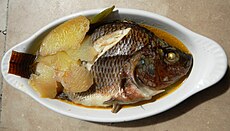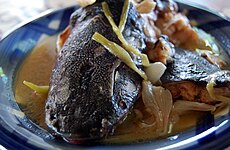  | |
| Type | Stew |
|---|---|
| Place of origin | Philippines |
| Region or state | Southern Luzon |
| Created by | Filipino cuisine |
| Main ingredients | Fish, tomatoes, salt, souring agent (calamansi, bilimbi, tamarind, santol, etc.) |
| Similar dishes | Sinigang, paksiw |
Pinangat na isda, also called pangat na isda, is a Filipino dish from Southern Luzon consisting of fish and tomatoes stewed in a broth soured with fruits like calamansi, bilimbi, tamarind, or santol. It can also be used to cook shrimp. It is similar to sinigang , but it is not as tart. [1] [2] [3] [4] [5] [6]
Pinangat na isda may also sometimes be referred to as paksiw , a related but different dish which primarily uses vinegar to sour the broth. [7] [8] Pinangat na isda is also commonly confused with laing (also called pinangat na laing or pinangat na gabi), a Bicolano dish also known simply as pinangat. But they are different dishes. [9] [4]
Emilio Aguinaldo’s favorite dish is home cooked pinangat na isda. A top Filipino cuisine, it is steamed fish like tilapia with a fusion of ground chicharrón, patís, burong mangga, labanos or tomato with unsoy sprigs. The steamed fish variations can include Alakaak, Bakoko, Bangus, Bisugo, Bugaong, Hito, Kitang or Sapsap. [10]
